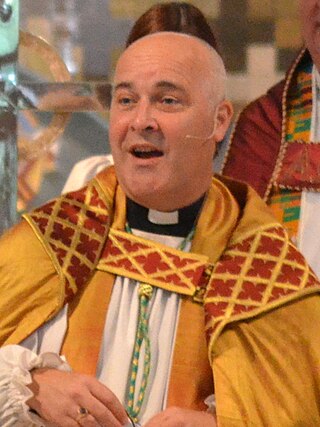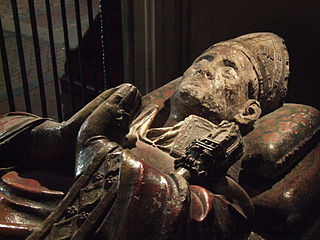William Whittlesey was a Bishop of Rochester, then Bishop of Worcester, then finally Archbishop of Canterbury. He also served as Master of Peterhouse, Cambridge.

John Alcock was an English churchman, bishop and Lord Chancellor.

John Stafford was a medieval English prelate and statesman who served as Lord Chancellor (1432–1450) and as Archbishop of Canterbury (1443–1452).
Silvester de Everdon was a medieval Bishop of Carlisle and Lord Chancellor of England.
John Langton was a chancellor of England and Bishop of Chichester.

Walter de Stapledon was Bishop of Exeter 1308–1326 and twice Lord High Treasurer of England, in 1320 and 1322. He founded Exeter College, Oxford and contributed liberally to the rebuilding of Exeter Cathedral. His tomb and monument, of great architectural importance, survives in Exeter Cathedral. He was killed by a mob during the London uprising.

Piers Butler, 8th Earl of Ormond, 1st Earl of Ossory also known as Red Piers, was from the Polestown branch of the Butler family of Ireland. In the succession crisis at the death of Thomas Butler, 7th Earl of Ormond he succeeded to the earldom as heir male, but lost the title in 1528 to Thomas Boleyn. He regained it after Boleyn's death in 1538.
Jocelin of Wells was a medieval Bishop of Bath. He was the brother of Hugh de Wells, who became Bishop of Lincoln. Jocelin became a canon of Wells Cathedral before 1200, and was elected bishop in 1206. During King John of England's dispute with Pope Innocent III, Jocelin at first remained with the king, but after the excommunication of John in late 1209, Jocelin went into exile. He returned to England in 1213, and was mentioned in Magna Carta in 1215.

The Archbishop of York is a senior bishop in the Church of England, second only to the Archbishop of Canterbury. The archbishop is the diocesan bishop of the Diocese of York and the metropolitan bishop of the province of York, which covers the northern regions of England as well as the Isle of Man.

The Bishop of Rochester is the ordinary of the Church of England's Diocese of Rochester in the Province of Canterbury.

John Sheppey was an English administrator and bishop. He served as treasurer from 1356 to 1360. Little is known of his family and background. A Benedictine, he was ordained deacon in 1318, and later studied at Oxford. Later he became involved in royal government, and was made bishop of Rochester on 22 October 1352. He was consecrated on 10 March 1353. He died on 19 October 1360, and was buried in Rochester Cathedral at the altar of St John the Baptist. As his will shows, he was a friend of his predecessor in the treasury, William Edington.
Putta was a medieval Bishop of Rochester and probably the first Bishop of Hereford. Some modern historians say that the two Puttas were separate individuals.
Osbern FitzOsbern was a Norman churchman. He was a relative of King Edward the Confessor as well as being a royal chaplain. During Edward's reign he received the church at Bosham, near Chichester. He was present at the consecration of Westminster Abbey at Christmas 1065. He was a steward for King William I of England during his reign, as well as being a friend of the king. The story that he became William's chancellor is based entirely on a charter that modern historians have declared mostly spurious. He became Bishop of Exeter in 1072, and was consecrated at St. Paul's in London on 27 May 1072 by the Archbishop of Canterbury, Lanfranc.

Robert de Stratford was an English bishop and was one of Edward III's principal ministers.
Edmund Audley was Bishop of Rochester, Bishop of Hereford and Bishop of Salisbury.
Simon of Wells was a medieval Bishop of Chichester.
Stephen Patrington was a medieval Bishop of St. David's and Bishop of Chichester.
Richard Peche was a medieval Bishop of Lichfield.
Robert of Chichester was a medieval Bishop of Exeter.









